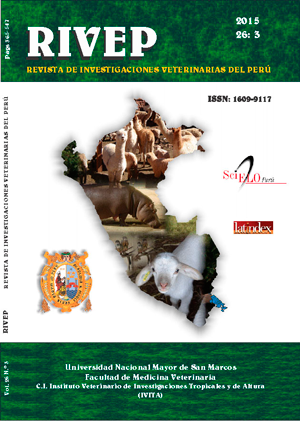Effect of four sperm separation methods on quality and in vitro fertilizing capacity of cryopreserved stallion spermatozoa
DOI:
https://doi.org/10.15381/rivep.v26i3.11188Keywords:
semen quality, centrifugation, cryopreservation, in vitro fertilizationAbstract
The aim of this study was to evaluate the effect of four separation methods on seminal quality and in vitro fertilizing capacity of equine cryopreserved spermatozoa. Straws of equine cryopreserved semen were used for sperm separation through the Androcoll, CushionFluid, EquiPure and Percoll methods. A Sperm Class Analyzer (SCA®) system was used to determine total motility, progressive motility, curvilinear velocity, linear velocity and average speed. Also, intact acrosome and sperm vitality were evaluated by fluorescence microscopy. In vitro fertilizing capacity was assessed by in vitro fertilization of bovine oocytes with spermatozoa obtained by each separation method.Cleavage rates were determined after three days of in vitro culture. The results were analyzed using generalized linear models (GLM) and means of the four methods were compared using the Tukey test. The CushionFluid was superior for most parameters of sperm motility as well as for intact acrosome (p<0.05). Higher means of sperm vitality were obtained with EquiPure and Percoll (p<0.05), but no difference were found on cleavage rates between treatments. It was concluded that cryopreserved stallion semen selected by the CushionFluid method had better sperm quality compared to the other three methods; however no difference was evident between them for in vitro fertilizing capacity of spermatozoa.
Downloads
Downloads
Published
Issue
Section
License
Copyright (c) 2015 Elizabeth Varela G., Juan Esteban Duque C., Mónica Ramírez H., Daniel Ocampo V., Juan David Montoya P., Giovanni Restrepo B.

This work is licensed under a Creative Commons Attribution-NonCommercial-ShareAlike 4.0 International License.
AUTHORS RETAIN THEIR RIGHTS:
a. Authors retain their trade mark rights and patent, and also on any process or procedure described in the article.
b. Authors retain their right to share, copy, distribute, perform and publicly communicate their article (eg, to place their article in an institutional repository or publish it in a book), with an acknowledgment of its initial publication in the Revista de Investigaciones Veterinarias del Perú (RIVEP).
c. Authors retain theirs right to make a subsequent publication of their work, to use the article or any part thereof (eg a compilation of his papers, lecture notes, thesis, or a book), always indicating the source of publication (the originator of the work, journal, volume, number and date).



